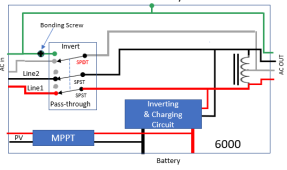shopman
Solar Enthusiast
Yes it is a low frequency inverter. Ian was also wrong in his description of the inverter board putting out 240vac. It puts out 28vac at 60hz which is stepped up by the transformer. Xantrex/Schneider works the same way. While it is a fact that the transformer is indeed placed across the grid when in bypass mode(not a great thing), it's not a bad inverter when used off grid. I've been running the 8kw model for a year and a half without a single problem. It's been a trouble free, reliable inverter. No flickering lights. No stray AC voltage appearing on the solar panel frames or any of the other issues that plauge many of the other inverters on the market. Starts and runs everything I've thrown at it, and believe me I've tortured it. Spot welder, mig welder, table saw, mill, lathe etc., all while powering the entire house.
In Will's latest video about the new EG4 battery someone commented about this inverter and Ian's video. Will's reply was brutal and uncalled for, in my opinion. Telling someone their inverter is junk and that they should get a new one is easy to do when manufacturers give you everything for free. Not everyone can afford to drop $5k or more on the latest and greatest inverter that comes along. That comment severely lowered my opinion of Will as well.
In Will's latest video about the new EG4 battery someone commented about this inverter and Ian's video. Will's reply was brutal and uncalled for, in my opinion. Telling someone their inverter is junk and that they should get a new one is easy to do when manufacturers give you everything for free. Not everyone can afford to drop $5k or more on the latest and greatest inverter that comes along. That comment severely lowered my opinion of Will as well.



